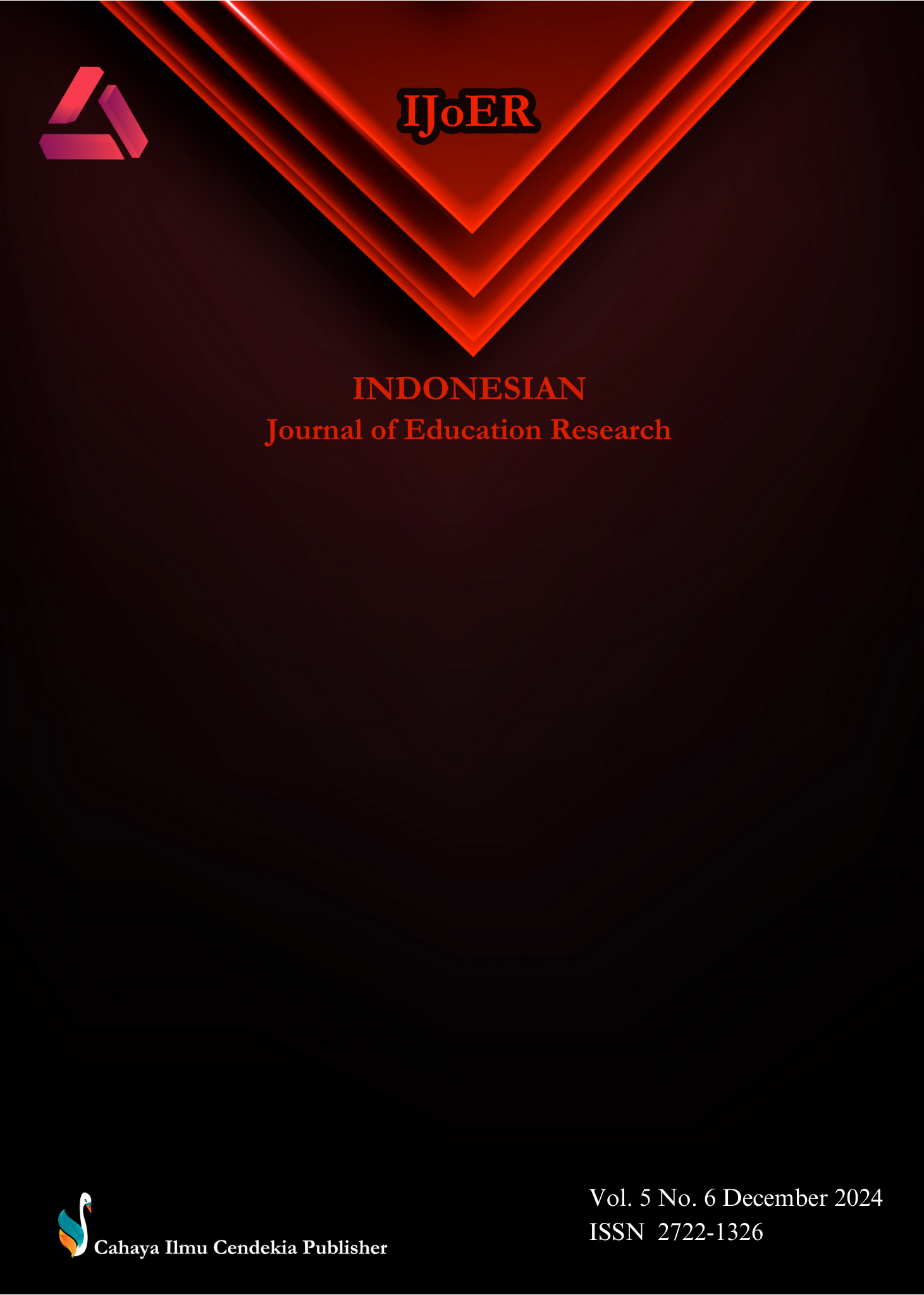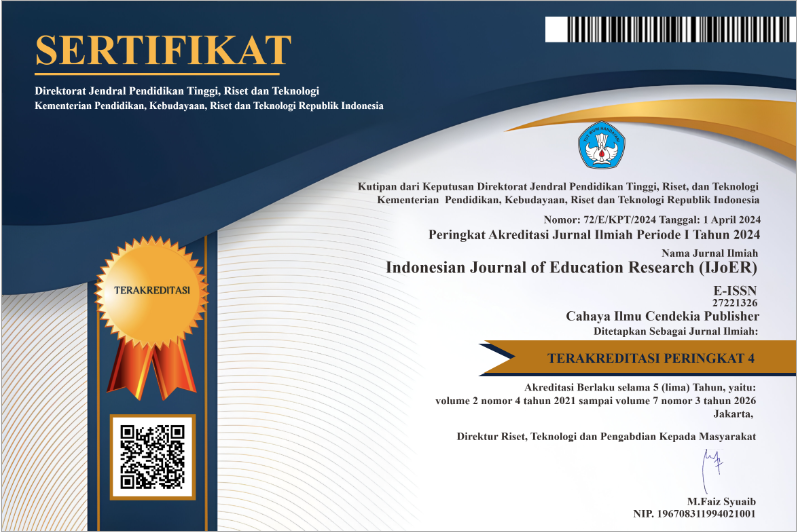A Analysis of Learners' Needs for Energy Literacy as a Reference for E-Module Development at Waterfall Edupark
Abstract
Purpose of the study: This research aims to analyze the needs of students in learning physics related to energy literacy by utilizing the potential of waterfalls as a reference for developing e-modules in Edupark.
Methodology: The methodology of this study is survey- quantitative descriptive research. Data collection through questionnaires given to respondents using google form. The research location is at Senior High School 1 Prabumulih, Senior High School 04 Ogan Komering Ulu, Senior High School 1 Merapi Timur, Senior High School 6 Prabumulih, Senior High School 1 Makarti Jaya, Senior High School 1 Bayung Lencir, Senior High School 10 Palembang, Senior High School 2 Palembang, Senior High School 1 Unggulan Muara Enim.
Main Findings: The findings of this study tentang Do you think physics is a difficult subject to learn percentage 64%, Have you ever visited a waterfall before percentage 50,1%, Have you ever been taught energy related concepts on waterfalls percentage 31,5%, Have you ever been taught using E-Modules related to waterfall eduparks percentage 51%, Have you ever heard of hydropower before percentage 87,1%, Do you agree that hydropower can provide more stable energy than other renewable energy sources percentage 89,1%.
Novelty/Originality of this study: The novelty of this study lies in the e-module associated with the waterfall edupark towards students' energy literacy. The findings can provide new insights in the context of education and researchers to develop appropriate innovations to improve e-modules.
References
D. Gustian, M. Marzuki, N. Nukman, Y. Purnama, dan D. Abdurrahman, “Synergies in Education: Integrating Character, Literacy, and Technology for Enhanced Outcomes: Current Perspectives From Global Education Experts,” Int. J. Teach. Learn., vol. 2, no. 2, hal. 498–512, 2024, https://injotel.org/index.php/12/article/view/84.
H. Ibda, “Penguatan Literasi Baru Pada Guru Madrasah Ibtidaiyah Dalam Menjawab Tantangan Era Revolusi Industri 4.0,” J. Res. Thought Islam. Educ., vol. 1, no. 1, hal. 1–21, 2018, doi: 10.24260/jrtie.v1i1.1064.
M. A. Aziz, S. Astutik, dan R. W. Bachtiar, “Pengembangan Lembar Kerja Siswa (LKS) untuk Meningkatkan Kemampuan Literasi Energi Siswa SMA,” Proc. ICECRS, vol. 1, no. 3, 2018, doi: 10.21070/picecrs.v1i3.1399.
M. Usman, Suyanta, Pujianto, dan K. Huda, “Energy Literacy of Junior High School Students in Indonesia: A Preliminary Study,” Proc. 6th Int. Semin. Sci. Educ. (ISSE 2020), vol. 541, no. January 2021, 2021, doi: 10.2991/assehr.k.210326.088.
J. DeWaters dan S. Powers, “Establishing measurement criteria for an energy literacy questionnaire,” J. Environ. Educ., vol. 44, no. 1, hal. 38–55, 2013, doi: 10.1080/00958964.2012.711378.
T. Dangkua, Y. Mooduto, dan A. Tilome, “Energy Literacy Education Characteristics in Gorontalo City, Indonesia: Cognitive Scale,” J. La Lifesci, vol. 3, no. 2, hal. 82–91, 2022, doi: 10.37899/journallalifesci.v3i2.608.
Y. Akitsu, K. Ishihara, H. Okumura, dan E. Yamasue, “Investigating energy literacy and its structural model for lower secondary students in Japan,” Int. J. Environ. Sci. Educ., vol. 12, no. 5, hal. 1067–1095, 2017, https://eric.ed.gov/?id=EJ1145592.
L. K. Hendinata, T. Ardiwinata, dan F. K. T. Pratama, “The Role of Energy Literacy in Supporting Energy Conservation: Perspective from Indonesian Citizens,” Indones. J. Energy, vol. 5, no. 2, 2022, doi: 10.33116/ije.v5i2.113.
M. Yusup, “Analisis Kurikulum Fisika Sma Dalam Perspektif Literasi Energi,” J. Inov. dan Pembelajaran Fis., hal. 48–53, 2017, http://fkip.unsri.ac.id/index.php/menu/104
S. Sukendar dan A. Setiawan, “High School Physics Teacher’s Profile In Teaching For Improving Student’s Energy Literacy,” J. Sci. Educ. Res., vol. 2, no. 1, hal. 25–30, 2018, doi: 10.21831/jser.v2i1.19330.
N. Hanifah, “Materi Pendukung Literasi Sains,” Gerak. Literasi Nas., hal. 1–36, 2017.
luul Maknuniyah, S. Astutik, dan I. Wicaksono, “Pengaruh Model Pembelajaran Collaborative Creativity (CC) terhadap Kemampuan Literasi Energi pada Siswa SMA,” J. Pembelajaran Fis., vol. 8, no. 2, hal. 87–93, 2019.
A. Waskita dan H. Rifai, “Needs Analysis of Design for the Integrated Project-Based Learning Module at Edupark Physics Science and Technology Center Sawahlunto,” Phys. Learn. Educ., vol. 1, no. 4, hal. 217–224, 2023, doi: 10.24036/ple.v1i4.94.
Saputri Sukma, Dwi Oktavallyan Saputri, dan Atik Prihatiningrum, “Perancangan Taman Wisata Edukasi Dengan Pendekatan Arsitektur Ekologi Di Kota Bengkulu,” Teknosia, vol. 17, no. 2, hal. 70–79, 2023, doi: 10.33369/teknosia.v17i2.28855.
P. Ramadhani, U. N. Padang, F. Novitra, U. N. Padang, dan P. Korespondensi, “Analisis Awal Tiger Camp Lubuk Minturun Kota Padang Sebagai Edupark Dalam Pembelajaran,” no. 3, hal. 315–322, 2023.
S. N. Sari dan H. Rifai, “Preliminary Analysis of the Physics Enrichment Book Design-Edupark Hot Waterboom Solok Selatan Integrated Inquiry Learning Model,” Phys. Learn. Educ., vol. 1, no. 4, hal. 248–258, 2023, doi: 10.24036/ple.v1i4.105.
H. Rifai, “Pengintegrasian Wahana Permainan Wisata Alam Ngarai Sianok dan Wisata Buatan MiFan Water Park Padang ke dalam Materi Fisika,” J. Eksakta Pendidik., vol. 3, no. November, 2019, doi: 10.24036/jep/vol3-iss2/400.
H. Khairunnisa, J. S. Prasetyo, P. T. Jehane, dan A. Asyianita, “Kajian Pengembangan Wisata Edukasi Berbasis Konservasi di Taman Hutan Raya K.G.P.A.A MANGKUNEGORO I Karanganyar,” J. Bio Educ., vol. 4, no. 2, hal. 25–34, 2019.
M. Al Hanif dan B. Santosa, “Development of E-Modules Based on Project Learning in Vocational High Schools,” J. Vocat. Educ. Stud., vol. 6, no. 2, hal. 264–276, 2022, doi: 10.12928/joves.v6i2.9304.
G. O. Elvisa dan H. Rifai, “The validity of the science edupark E-Book with a scientific approach based on Padang Beach tourism destinations,” J. Phys. Conf. Ser., vol. 1876, no. 1, 2021, doi: 10.1088/1742-6596/1876/1/012059.
A. Wulandari dan - Hamdi, “Validity of Physics Mobile Learning Media Edupark of Bayangsani South Coast Fluid on Fluid Material for High School Students Using the Android Studio Application,” Pillar Phys. Educ., vol. 13, no. 4, hal. 475, 2021, doi: 10.24036/10154171074.
Y. Lastri, “Pengembangan Dan Pemanfaatan Bahan Ajar E-Modul Dalam Proses Pembelajaran,” J. Citra Pendidik., vol. 3, no. 3, hal. 1139–1146, 2023, doi: 10.38048/jcp.v3i3.1914.
R. A. Yunita dan - Hamdi, “The Practicality of Integrated High School Physics Edupark Ebook Sarasah Kajai Waterfall Destinations with a Scientific Approach to the Industrial Revolution 4.0,” J. Penelit. Pembelajaran Fis., vol. 9, no. 1, hal. 86, 2023, doi: 10.24036/jppf.v9i1.121455.
P. Sari, Ayu dan H. Hamdi, “Praktikalitas Ebook Edupark Fisika Menggunakan Pendekatan Saintifik pada Destinasi Wisata Panorama Tabek Patah,” J. Penelit. Pembelajaran Fis., vol. 7, no. 2, hal. 136, 2021, doi: 10.24036/jppf.v7i2.112052.
A. C. Dewi, “Pemahaman Guru TK Tentang Konten Pembelajaran SAINS AUD di Kecamatan Padang Panjang Barat Kota Padang Panjang,” Kiddie Early Child. Educ. Care J., vol. 1, no. No 1, hal. 69–85, 2023, https://doi.org/10.52593/kid.01.1.06
F. S. H. Sinkha Arza Khaq1, Fadila Nur Rohmah2, Mutiara Triana Zain3, Cindy Febiana4, “Analisis Kesulitan Belajar Ipa Pada Materi Energi Alternatif Kelas IV Sekolah Dasar,” Autentik J. Pengemb. Pendidik. Dasar, vol. 8, no. 1, hal. 35–41, 2024, doi: 10.36379/autentik.v8i1.471.
Sadraini dan Hamdi, “Praktikalitas dari Pengembangan E-book Edupark Fisika dengan,” J. Penelit. dan Pembelajaran Fis., vol. 7, no. 1, hal. 94–100, 2021.
E. Vagnoni et al., “The new role of sustainable hydropower in flexible energy systems and its technical evolution through innovation and digitalization,” Renew. Energy, vol. 230, no. February, 2024, doi: 10.1016/j.renene.2024.120832.
Z. Liu dan X. He, “Balancing-oriented hydropower operation makes the clean energy transition more affordable and simultaneously boosts water security,” Nat. Water, vol. 1, no. 9, hal. 778–789, 2023, doi: 10.1038/s44221-023-00126-0.
H. M. Ramos, J. E. Sintong, dan A. Kuriqi, “Optimal integration of hybrid pumped storage hydropower toward energy transition,” Renew. Energy, vol. 221, no. November 2023, hal. 119732, 2024, doi: 10.1016/j.renene.2023.119732.
R. Sahay dan C. Engineering, “Micro-Hydro Power-Harnessing the Potential Energy of Water for Small-Scale Electricity Generation,” vol. 1, no. 1, hal. 13–17, 2024, https://ijrasht.com/index.php/files/article/view/110.
Copyright (c) 2024 Fitria Siska Damayanti, Hamdi Akhsan, Muhamad Yusup, Nor Farahwahidah Abdul Rahman

This work is licensed under a Creative Commons Attribution 4.0 International License.
Authors who publish with this journal agree to the following terms:
- Authors retain copyright and acknowledge that the Indonesian Journal of Education Research (IJoER) is the first publisher licensed under a Creative Commons Attribution 4.0 International License.
- Authors are able to enter into separate, additional contractual arrangements for the non-exclusive distribution of the journal's published version of the work (e.g., post it to an institutional repository or publish it in a book), with an acknowledgment of its initial publication in this journal.
- Authors are permitted and encouraged to post their work online (e.g., in institutional repositories or on their website) prior to and during the submission process, as it can lead to productive exchanges and earlier and greater citation of published work.







.png)
.png)




















